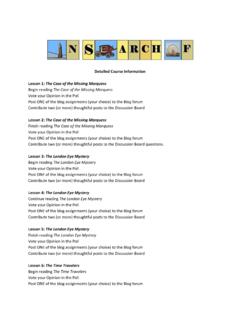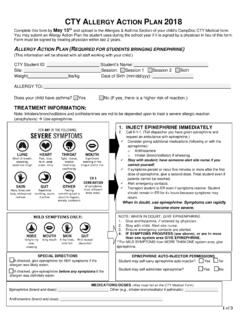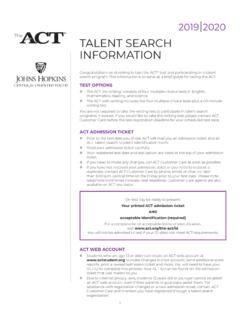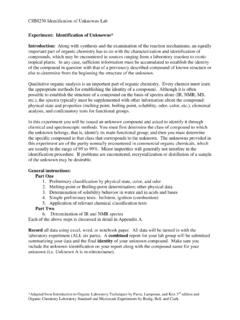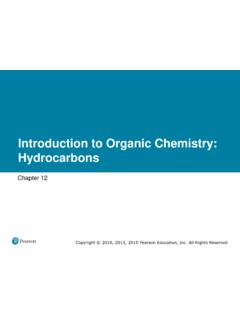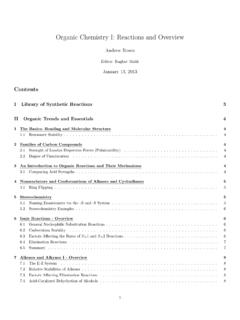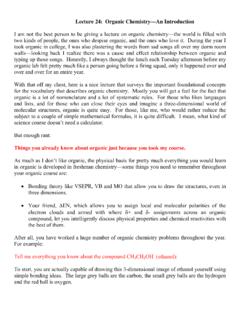Transcription of Introduction to Organic Chemistry - Center for Talented Youth
1 Introduction to Organic Chemistry Syllabus Day 1: Session 1 (evening session): 1. Introduction to Organic Chemistry : 2. General discussion about what is Chemistry ? 3. What is Organic Chemistry ? 4. What is an Organic compound? 5. Why is 90% of research in Chemistry about Organic Chemistry ? 6. What are the different branches of Chemistry ? 7. Pre-assessment Day 2: Session 1: (9-11:30am) 1. Similarities game 2. Nomenclature 3. Functional Groups 4. Carbon Classification 5. Classification of Alcohols 6. Classification of Amines 7. Reactions of Alkanes: substitution (nucleophilic and electrophilic) Day 2: Session 2: (12:30-3pm) 1.
2 Properties of Carbon and other molecules 2. Reactions of unsaturated hydrocarbons: addition of H2 to alkene to form saturated hydrocarbon 3. Types of Formulae: Molecular Formula Structural Formula Line-Angle Formula 4. Kinds of matter: solid, liquid, gas, plasma, and BEC 5. Naming rules: IUPAC 6. Naming Cyclic Alkanes Day 2: Session 3: (7-9pm) Aromatic Compounds Practice problems: Naming substituted benzenes Textbook Practice Problems Day 3: Session 1: 1. Isomers Chain isomerism Positional isomerism Functional group isomerism Geometric isomerism (cis and trans) 2.
3 Conformations 3. Building molecules using molecular model kits 4. Steric hindrance and energy diagrams Day 3: Session 2 Preparation of Esters Lab Cis Trans Isomerization Lab Day 3: Session 3 Finished the cis trans isomerization reaction, left it to dry overnight, and did practice problems Day 4: Session 1 Preparation of Alkanes Chemical Reactions of Alkanes Relative stability of alkyl radicals Reactivity-Selectivity Principle Radical Substitution of Benzylic and Allylic Hydrogens Reaction Mechanisms Day 4: Session 2 Preparation of Alkenes Chemical Reactions of Alkenes Textbook practice problems for Alkene Reactions Preparation of Alkynes Chemical Reactions of Alkynes Day 4: Session 3 Properties of Hydrocarbons Lab Finishing Cis Trans Isomerization Las - measure percent yield and analyzed sources of error in the isomerization lab Day 5: Session 1 Chemical and Physical Properties of Alkenes (Review) Dienes- Introduction Nomenclature of Dienes Methods of Extraction of Dienes Chemical Properties of Dienes Day 5.
4 Session 2 Finish Properties of Hydrocarbons Lab Lab Report: Preparation of Esters Lab extension: Bromination of Alkenes Post-Lab Discussion Day 5: Session 3 Real World Problems- Textbook pg 124-128 E-Z Nomenclature Day 6: Session 1 (Friday) Halogenoalkanes- Introduction Structure of HA Nucleophilic Substitution Elimination Reaction Substitution vs. Elimination Uses of HA s CFC s E-Z Nomenclature (continued) Day 6: Session 2 (Friday) Identification of Organic Compounds Lab Post lab discussion Day 7: Session 1 (Sunday evening session) Review- Week 1 Chirality Day 8: Session 1 (Monday) Chirality (continued) Enantiomers Stereoisomers R-S System Diastereomers Racemic Mixture Day 8: Session 2 Basic Column Chromatography Lab Post lab discussion Day 8: Session 3 Optical activity Review Worksheet Day 9: Session 1 (Tuesday) 1.
5 Optical activity 2. Racemic mixture 3. Resolution of enantiomers 4. Alcohols: Structure Classification and IUPAC naming Alkenols Priority Physical Properties Chemical Properties Day 9: Session 2 Extraction and Isolation of Caffeine Lab (Extraction Part) Day 9: Session 3 Continued working on Extraction of Caffeine lab Real World Problems Chemical Connections Review Day 10: Session 1 (Wednesday) Acidity of Alcohols Dehydration (Acid-catalyzed dehydration, Zaitzev s rule) Oxidation of Alcohols Dehydration vs. Oxidation Preparation of Important Alcohols Day 10: Session 2 Extraction and Isolation of Caffeine Lab (Isolation part) Post lab discussion Day 10: Session 3 Review (Week 2) Textbook Problems Day 11: Session 1(Thursday) Benzene Nomenclature Polynuclear Aromatic Hydrocarbons and LPAH s Synthesis Physical Properties Chemical Properties Day 11: Session 2 Uses of Benzene Extraction and Isolation of Caffeine from Tea Lab (Identification part) Day 11: Session 3 Worksheets 1.
6 Benzene Day 12: Session 1 (Friday) Lecture: Benzene Sulfonation Nitration of Toluene Activating O, P-directing substituents Activity: Posters (in pairs) for bromination, chlorination, nitration and sulfonation of benzene Day 12: Session 2 (Friday) Poster Presentations Lecture: Benzene Substitution Anisole Amino group Summary of Activation Halobenzene Friedel-Crafts Alkylation Day 13: Session 1 (Sunday evening session) Friedel Crafts Acylation Review of Benzene Review of both Friedel-Crafts Reactions Activity: Drawing out mechanisms for Friedel Crafts Reactions Day 14: Session 1 (Monday) Reactions of Benzene Derivatives Oxidation Reactions Alkyl Benzene Halogenation of Toluene Synthesizing a Substituted Aromatic Compound Uses of Benzene Uses of Toluene Day 14: Session 2 Synthesis of AspirinLab Post lab discussion Day 14: Session 3 Alcohols Worksheets Benzene (Kahoot) Review Day 15.
7 Session 1 (Tuesday) Amines Introduction Nomenclature Physical Properties Chemical Properties Amine Salts Amides Amides from amines Amide reactions Synthesis of Nylon Physical Properties of Amides Day 15: Session 2 Complete Synthesis of Aspirin Lab Day 15: Session 3 Review of Aromatic Compounds Day 16: Session 1 (Wednesday) Carbonyl Compounds Aldehydes and Ketones Nomenclature Isomerism Physical Properties Preparation of Aldehydes and Ketones Chemical Properties Keto-enol tautomerization Day 16: Session 2 Oxidation of an Aldehyde to Acid Lab Post lab discussion Day 16: Session 3 Carboxylic acids Nomenclature Isomerism Physical Properties Preparation of Aldehydes and Ketones Chemical Properties Esters Nomenclature Isomerism Physical Properties Chemical Properties Ethers Nomenclature Isomerism Physical Properties Chemical Properties Day 17: Session 1 (Thursday) Polymer Chemistry Characterizing a Polymer Structure Classification Synthesis Types of reactions Activity: Polymer building Day 16.
8 Session 2 Review Post-Assessment Discussions Day 17: Session 1 (Friday- Last day) Review and Quiz

